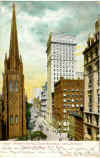 |
New York Architecture Images- Lower Manhattan TRINITY CHURCH (Episcopal) Landmark |
|
architect |
|
|
location |
78-79 Broadway at Wall Street |
|
date |
1846 |
|
style |
Gothic Revival |
|
construction |
Brownstone |
|
type |
Church |
| Click here for Trinity Church Gallery | |
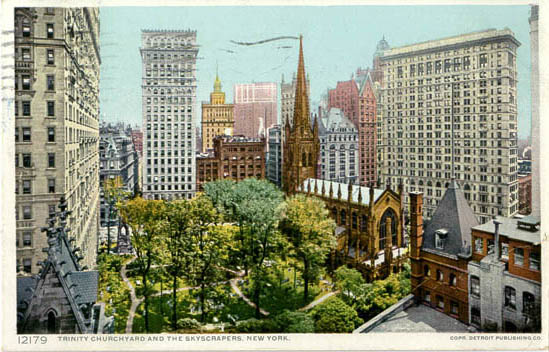 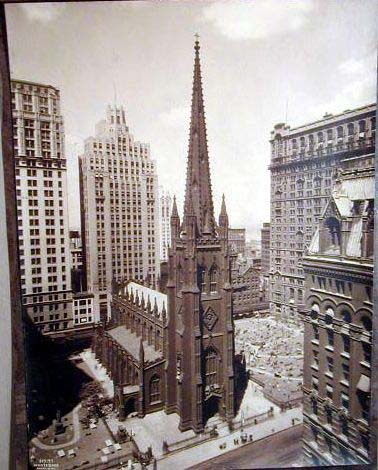 |
|
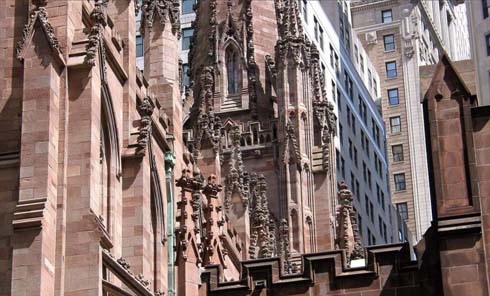 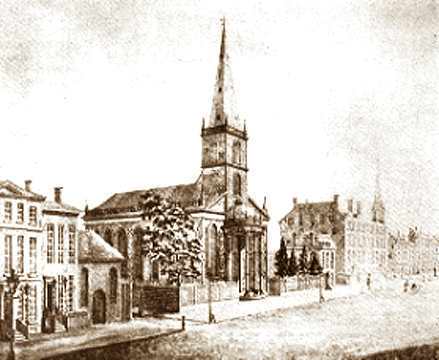 |
|
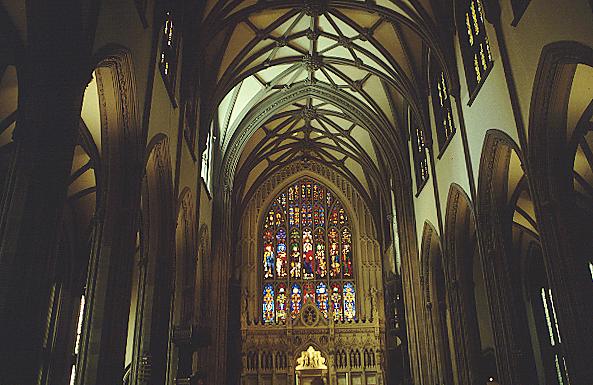 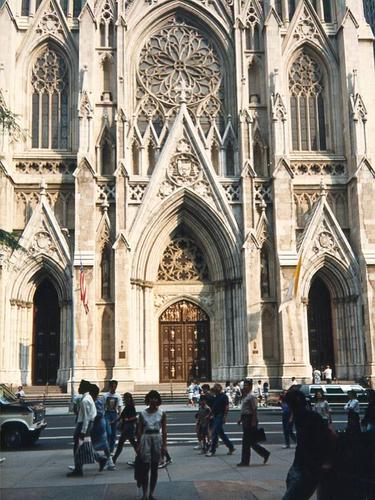 |
|
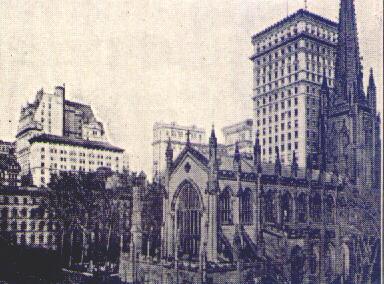 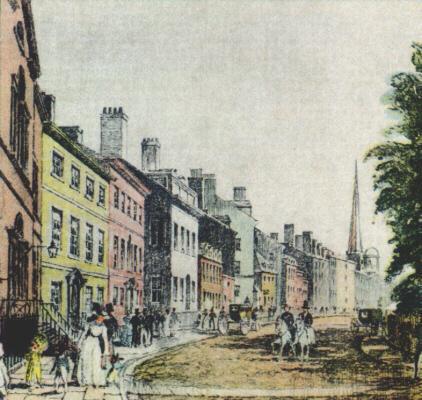 |
|
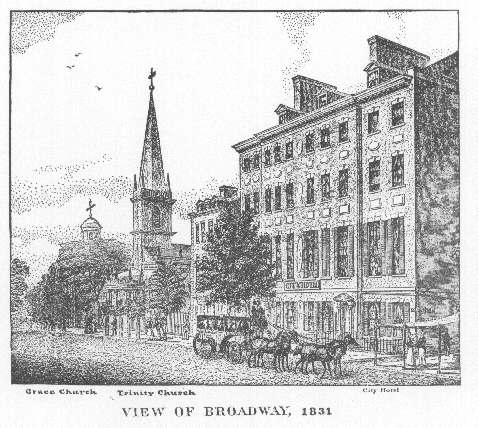 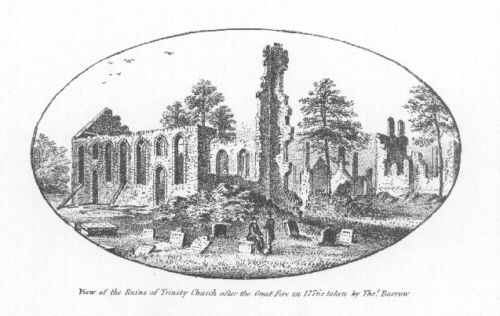 |
|
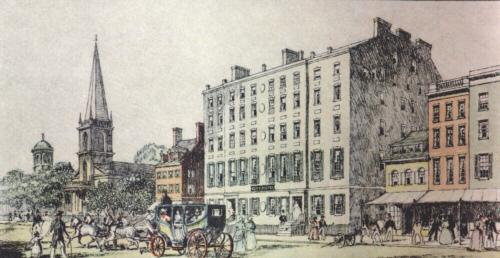 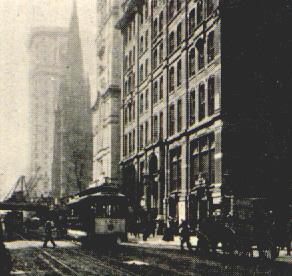 |
|
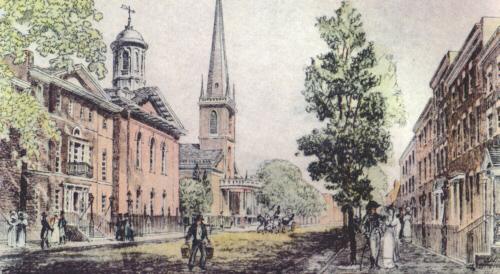 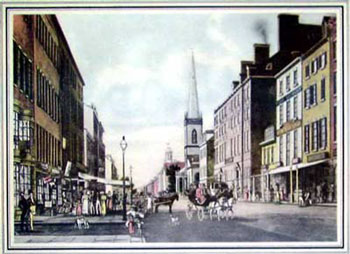 |
|
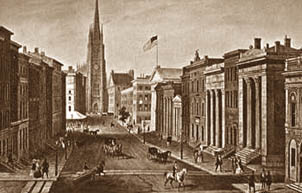 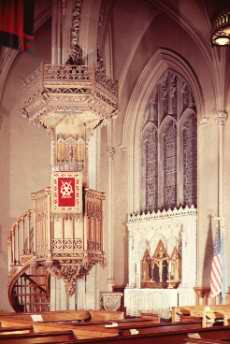 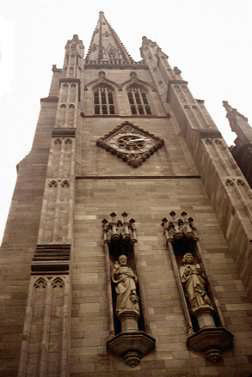 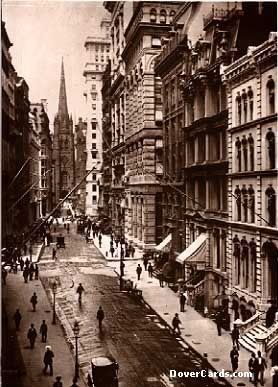 |
|
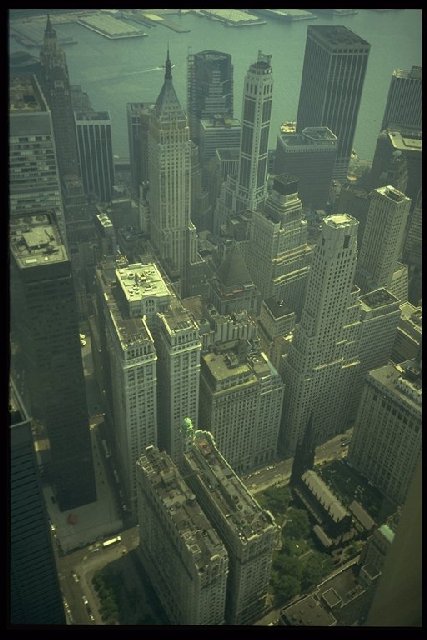 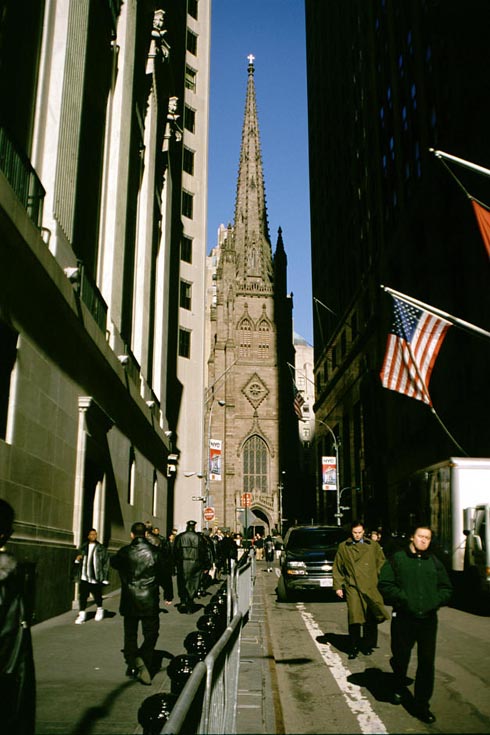 |
|
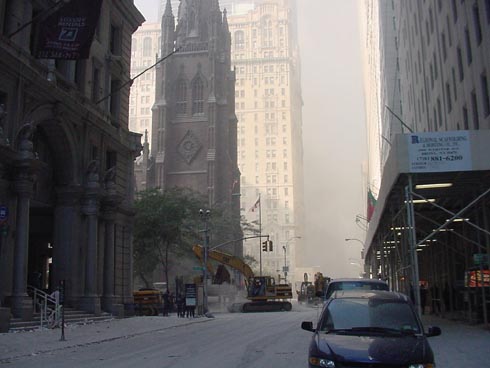 |
|
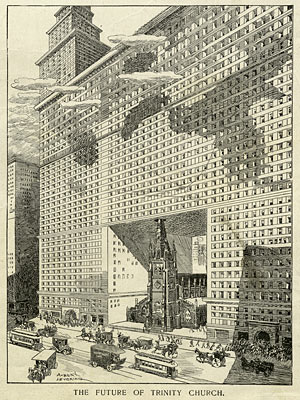 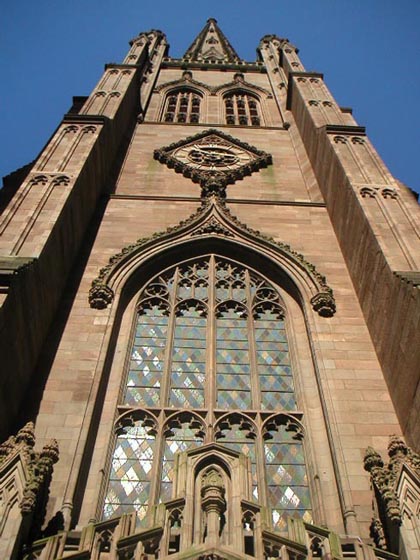 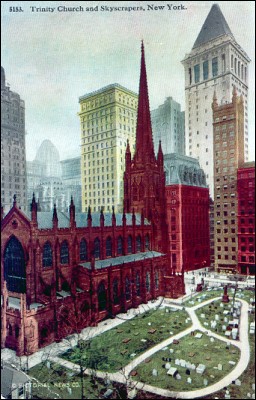 |
|
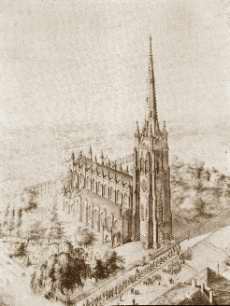 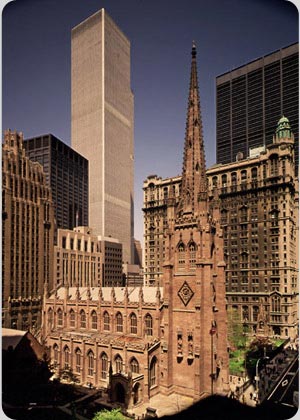 |
|
|
notes |
Prominently located at the terminus of Wall Street on land granted to the
congregation by the British crown, this Anglican church has served as an
urban landmark since the 19th century. The third church to stand on this
site, the current Trinity Church was built by an English cabinet maker who
immigrated to the United States and became a leader of the American Gothic
Revival. The basilica plan church is built in the English Perpendicular
Gothic Style of the 14th century, signaling the arrival of Gothic Revival
ideals brought from England to New York in the mid 19th century. The
church's stained glass windows recall medieval models, while its ornate
bronze doors echo the doors of Florence's Renaissance Baptistry. The use of
brownstone signals a popular interest in locally available materials.
Burned During War, Trinity Is Home
Trinity's beautifully kept chuchyard predates the church's establishment by Royal Charter in 1697. Initially it was a Dutch burial ground. Among the 1,186 graves are those belonging to William Bradford, printer to the U.S. Goverment for more than half a century; to Robert Fulton, the first person to successfully apply steam power to ship locomotion; and to Alexander Hamilton, first Secretary of the Treasury. A reminder of Trinity's regal beginnings is the heroic statue in the southeast part of the cemetary near Broadway. It is of John Watts, the last Royal Recorder of the City of New York, who died in 1863. He served the newly independent country as a U.S. Congressman, endowed an orphanage, and was a co-founder of a public health clinic.
John William Hill (American, b. England,
1812–1879)
News Report on Wall Trade Center Attack
and Trinity Wall Street
When the first aircraft hit New York's World Trade Center during the morning rush-hour on Tuesday September 11, young children were arriving at Trinity Wall Street's pre-school, staff were on the streets around the center, and Archbishop Rowan Williams of Wales was preparing for a day's videotaping with Trinity Television. The Rev. Dr. Daniel P. Matthews, rector of the Parish of Trinity Church, and a group of colleagues were in a meeting in the parish's office tower three blocks from the center. "We were on the 24th floor, which has a view of the World Trade Center, when we heard the sound, and looked up to see a ball of fire coming from one of the towers. A few minutes later, we saw the second plane hit, and again a ball of fire erupted," he said. He was soon down in the building's lobby, reassuring shocked staffers as security staff sought guidance on the safest response. Before the first blast, staff on the streets around Trinity heard what to some sounded like military jets carrying out a low fly-past before hearing the blast. Within minutes, pieces of paper were raining from the sky onto the church, the churchyard and the surrounding streets. In Trinity Television's studio a small group of shocked visitors gathered as Trinity's director of television, Bert Medley, asked Archbishop Williams to lead the group in prayer. The Rev. Gay Silver went to minister to the teachers and pupils at the pre-school. The Rev. Lyndon Harris, who heads the ministry at historic St. Paul's Chapel across the street from the World Trade Center, set out for the chapel to see how he could help there. Before he arrived, the second aircraft hit the center and he was forced to return to Trinity to avoid flying debris. The Rev. Stuart Hoke, executive assistant to Dr. Matthews, was among those in the church leading prayers and hymns for shocked passers-by some time later when a tower at the WTC collapsed. The power was cut. Some of the congregation fled into Broadway, while others remained in the nave. Trinity's office tower shuddered and dust began to penetrate the building down lift shafts from the top. Staff who tried to leave the building found the lobby filled with dust, and were forced to return to upper floors to breathe. Outside, the pall of dust that had settled over the financial district with the tower's collapse had made it dark as night. Staff designated as fire wardens gathered at the pre-school to evacuate the children to the basement. Other staff searched the building, looking for places which were both as low down in the building and as dust-free as possible. Once breathing masks had all been handed out, towels in the pre-school were torn up and soaked in water for people to breathe through. When the order to evacuate the office block came, Trinity staffers and pre-school children filed out under the direction of security staff and fire wardens. They streamed down Greenwich Street at the back of the building, heading through the gloom and holding masks or towels to the their faces, to the south end of the island of Manhattan. When they heard the sounds of another collapse from the World Trade Center, they dashed for cover in doorways and under alcoves. Numbers boarded the Staten Island ferry across New York harbor to escape the downtown area, and others were evacuated by buses up the east side and to Brooklyn. Trinity News, September 11, 2001 ....Broadway actually was in a remote and obscure part of the town. Below Crown (Liberty) Street dwelling - houses had been erected, of which a few near the Bowling Green were prodigiously fine; but north of Crown Street all the west side of Broadway was open fields. This unimproved region, beginning at the present Fulton Street and thence extending northward, was the Church Farm.The estate known as the Company's Farm, set aside by the Dutch to be tilled for the benefit of the Company's servants, civil and military, lay between the present Fulton and Warren streets and Broadway and the North River. Upon the English conquest, this estate became the private property of the Duke of York. Subsequently, in the year 1670, by purchase from heirs of Annetje Jans, the boundary of the Duke's Farm was carried northward as far as the present Chariton Street; possibly as far as the present Christopher Street. When the Duke of York ascended the throne the property became known as the King's Farm : and as the Queen's Farm upon the accession of Queen Anne. In this last reign, in the year 1705. reserving a quit-rent of three shillings (which was extinguished in 1786 by a payment in gross), the then Governor, Lord Cornbury, granted the entire estate to the English Church on the Island of New York, The farm-house pertaining to this farm-standing very nearly upon the site of the present Astor House-is shown on Lyne's map, immediately to the south of the Broadway rope-walk. Later it became a tavern of some celebrity-the Drovers' Inn, kept by Adam Vanderberg. Undoubtedly, the church ownership of this large parcel of land tended to delay its utilization for building purposes, and so helped to retard the extension of the city on the line of Broadway. Even in those early days the strongly American desire to build on land owned in fee operated against the use of leasehold property. Not until the need for the Church Farm became pressing was it taken for improvement on the only terms upon which it could be acquired. TO BE SOLD, At Vendue, onTuefday the 12th inft, at the Houfe of Mr John Williams, near Mr Lifpenard's: A Leafe from TrinityChurch, for Old John's Land, for 12 Years to come - ADVERTISEMENT, 1766 ANNEKE OR ANNETJE JANS (? ---1663). An early Dutch colonist of New Netherland, famous because of lawsuits concerning her farm between her heirs and the corporation of Trinity Church, New York City. She emigrated from Holland to New Netherland with her husband, Roeloff Jansen, in 1630. In 1636 the latter obtained a grant of 62 acres of land on Manhattan Island , extending from the present Warren Street to the neighborhood of Desbrosses Street, and lying between Broadway and the Hudson River. Soon afterwards Jansen died, and she married the Dutch dominic Everardus Bogardus (q.v.). In 1654, after her husband's death, she secured a patent to the farm in her own name, and later removed to Albany, where she died, leaving her property to be divided among her eight surviving children. After the English had taken possession, in 1664, all property-holders were required to secure new titles for their lands. Accordingly, the heirs secured a new patent for the farm from Governor Nicolls, on March 27, 1667. Four years later, March 9, 1671, the property was sold to Governor Lovelace, all of the heirs signing the deed of transfer except the wife and child of Cornelius Bogardus, a son of Anneke and her second husband, who had died in 1666. It is largely upon this omission that the subsequent suits have been based. Upon the recall of Governor Lovelace (q.v.), the Government confiscated the Jans farm, and subsequently granted it to Trinity Church by a patent sealed on November 23, 1705. In 1749 Cornelius Brower, a descendant of the Cornelius Bogardus whose heirs had not signed, took forcible possession of a portion of the farm, and on being evicted began an action against Trinity Church, which was decided against him. In 1757 he made another unsuccessful attempt. Another Cornelius Bogardus took possession of part of the estate in 1784, and held it until he was evicted by the courts in 1786. His son John brought suit in 1830 to secure one-thirtieth of the farm and a proportionate share of back rents. In order to secure the money necessary to carry on this suit, he sent circulars to all the descendants of Anneke Jans asking them to contribute, which they did most liberally untill 1847, when judgment was again given for the church. Since then there have been several other suits brought by the heirs, but they have been uniformly decided in favor of the defendants. Consult: Nash, Anneke Jans Bogardus: Her Farm, and How it became the Property of Trinity Church, New York (New York, 1896) ; Sandford's Chancery Reports (vol. iv., pp. 633-672) ; Schuyler's Colonial New York (vol. ii.) ; and Harper's Monthly Magazine for May, 1885. *Source: The New International Encyclopaedia Publisher: Dodd, Mead and Company-New York Copyright: 1902-1905 Maerschaick's map (1755) shows that by the middle of the last century the growth of the city, creating this pressing need, had warranted the laying out of streets through the southern portion of 'the Church property, and that five-and twenty buildings had been erected between the present Liberty Street and the palisade. But the stronger tendency of growth, it will be observed, still was towards the northeast. Advance up the middle of the island was blocked by the Fresh Water pond and the western side it was impeded by the marshy valley known as Lipensard's Meadows. From the Bk : In Old New York Janvier, Thomas Orig. Copyright 1894 This bk is available at Barnes & Noble. It is in its 10th printing. The following is a time-line to the history of the Church lands and the Church http://www.trinitywallstreet.org/timeline.html Transcribers: Nancy E Lutz Miriam Medina |
|
Trinity Church, at 74 Trinity Place in New York City, is a historic full
service parish church in the Episcopal Diocese of New York. Trinity
Church is located at the intersection of Broadway and Wall Street in
downtown Manhattan. History and Architecture In 1696, Governor Benjamin Fletcher approved the purchase of land in Lower Manhattan by the Anglican community for construction of a new church. The parish received its charter from King William III of England on May 6, 1697. Its land grant specified an annual rent of one peppercorn due to the English crown. The present day Trinity Church, designed by architect Richard Upjohn, is considered a classic example of Gothic Revival architecture and was designated a National Historic Landmark in 1976 for its architectural significance and place within the history of New York City.[1],[3],[4] When the church was consecrated on Ascension Day May 1, 1846, its soaring Neo-Gothic spire, surmounted by a gilded cross, dominated the skyline of lower Manhattan. Trinity was a welcoming beacon for ships sailing into New York Harbor. Though skyscrapers have risen all around it, Trinity Church still stands as a significant statement of spiritual values in the heart of downtown Manhattan and serves as a center for contemplation, worship, and Christian community. The First Trinity Church The first Trinity Church building, a modest rectangular structure with a gambrel roof and small porch, was constructed in 1698. According to historical records, the infamous privateer Captain William Kidd lent the runner and tackle from his ship for hoisting the stones.[1] In 1705, Queen Anne of England increased the parish's land holdings to 215 acres (870,000 m²). In 1709, William Huddleston founded Trinity School as the Charity School of the church, and classes were originally held in the steeple of the church. And in 1754, King's College (now Columbia University) was chartered by King George II of Great Britain and instruction began with eight students in a school building nearby the church. During the American Revolutionary War the clergy were required to be Loyalists, while the parishioners included some members of the First and Second Continental Congresses. The church was destroyed in the Great New York City Fire of 1776 following the capture of the city by the British in the Battle of Long Island. The fire that started in the Fighting Cocks Tavern destroyed nearly 500 buildings and houses and left thousands of New Yorkers homeless. Six days later, most of the city's volunteer firemen followed General George Washington north. In 1784, the Rev. Dr. Samuel Provoost, is appointed Rector of Trinity (1784-1800) and the New York State Legislature ratifies the charter of Trinity Church, deleting the provision that asserted its loyalty to the King of England. Whig patriots are appointed as vestrymen. In 1787, the Rev. Provoost is consecrated as the first Bishop of the newly formed Diocese of New York. And in 1789, following his inauguration at Federal Hall, George Washington attends Thanksgiving service, presided over by Bishop Provoost, at St. Paul's Chapel, a chapel of the Parish of Trinity Church. He continues to attend services there until the second Trinity Church was finished in 1790. The Second Trinity Church Construction on the second Trinity Church building began in 1788; it was consecrated in 1790. The structure was torn down after being weakened by severe snows during the winter of 1838–39. In 1843, Trinity Church's expanding parish was divided due to the burgeoning cityscape and to better serve the needs of its parishioners. The newly formed parish would build Grace Church, to the north on Broadway at 10th street, while original parish would re-build the Trinity Church that stands today. Both Grace and Trinity Churches were completed and consecrated in 1846. The Trinity Church Cemeteries There are three burial grounds closely associated with Trinity Church. The first Trinity Churchyard, at Wall Street and Broadway, in which are interred Alexander Hamilton, William Bradford, Robert Fulton, Captain James Lawrence and Albert Gallatin. The second is Trinity Church Cemetery and Mausoleum on Riverside Drive at 155th Street, formerly the location of John James Audubon's estate, in which are interred John James Audubon, Alfred Tennyson Dickens, John Jacob Astor, and Clement Clarke Moore. The third is the Churchyard of St. Paul's Chapel. Bells The tower of Trinity Church currently contains 23 bells the heaviest of which weighs 27 cwt. Eight of these were cast for the original tower and were hung for ringing in the English change ringing style, although it is unlikely they were ever rung in this way in the new tower. Three more were subsequently added. In 1946 they were adapted for swing chiming and sounded by electric motors. A project to install a new ring of 12 additional change ringing bells was initially proposed in 2001 but put on hold in the aftermath of the 9/11 attacks which were so close to the church. It finally came to fruition in 2006 with funding from the Dill Faulkes Educational Trust. These bells form the first ever ring of 12 installed in a church in the USA. The work was to be carried out by Taylors, Eayre and Smith of Loughborough, England. The bells were installed in September 2006 and are now ringable. The excessive ringing of the bells for bell practice and tuning in September 2006 caused much concern to local residents, some of whose windows and residences are less than one hundred feet at eye level to the bell tower. A petition was started to stop the ringing of the bells, reflecting the changing nature of lower Manhattan to a residential area. Details of the individual bells can be found at: Dove's Guide for Church Bellringers. Services Trinity Church offers a full schedule of prayer and Eucharist services throughout the week and is also available for special occasions such as weddings and baptisms. In addition its historical daily worship, Trinity Church provides Christian fellowship and outreach to the community, the city, the nation and the world. Trinity Church also has a very rich music program. Their Concerts at One has been providing live professional classical and contemporary music for the Wall Street community since 1969. And the church has a several organized choirs including the Trinity Choir which is featured Sunday mornings on WQXR 96.3 FM in New York City. Staff The Rev. Dr. James Herbert Cooper, Rector The Rev. Canon Anne Mallonee, Vicar The Rev. Canon James G. Callaway, Deputy for Faith Formation The Rev. Dr. Stuart Hoke, Missioner and Staff Chaplain The Rev. Ruth Anne Garcia, Associate for Faith Formation Ms. Ali Lutz, Manager of Congregational Development Mr. Robert P. Ridgell, Assistant Organist and Director, Trinity Choristers Trivia St. Paul's Chapel, part of the Parish of Trinity Church, is the oldest public building in continuous use in New York City. Trinity Episcopal Church in Fishkill, New York was started in 1756 with the missionary assistance of Trinity Church. Photo of Trinity Church and the schoolhouse of Trinity School (c. 17??). At the time of its completion, in 1846, its 281-foot spire and cross was the highest point in New York until being surpassed in 1890 by the New York World Building. On July 9, 1976, the church was visited by Queen Elizabeth II of the United Kingdom, and she was presented with a symbolic "back rent" of 279 peppercorns. Since 1993, Trinity church has been the location which the High School of Economics and Finance holds their senior graduation ceremonies. The school is located on Trinity Place (a few blocks away from the church). In the film National Treasure, the treasure is hidden beneath Trinity Church. The parish has a large number of realty holdings, including 26 commercial buildings in Lower Manhattan (totaling nearly 6 million sq. ft. in office, retail, and manufacturing space) and 470 acres (1.9 km²) of land on the Housatonic River in West Cornwall, Connecticut. Trinity Church has started, endowed or aided more than 1,700 churches, schools, hospitals, and other institutions. Trinity Churchyard Cemetery is the only active cemetery remaining in the borough of Manhattan. On September 11th, 2001, debris from collapsing World Trade Center knocked over a giant sycamore tree that had stood for nearly a century in the churchyard of St. Paul's Chapel. Sculptor Steve Tobin used its roots as the base for bronze sculpture next to Trinity Church . References ^ a b Trinity Church and Graveyard. National Historic Landmark summary listing. National Park Service (2007-09-11). ^ National Register Information System. National Register of Historic Places. National Park Service (2007-01-23). ^ ["Trinity Church", August 1976, by Carolyn PittsPDF (396 KiB) National Register of Historic Places Inventory-Nomination]. National Park Service (1976-08). ^ [Trinity Church--Accompanying 5 photos, exterior, from 1973 and undated.PDF (521 KiB) National Register of Historic Places Inventory-Nomination]. National Park Service (1976-08). |
|